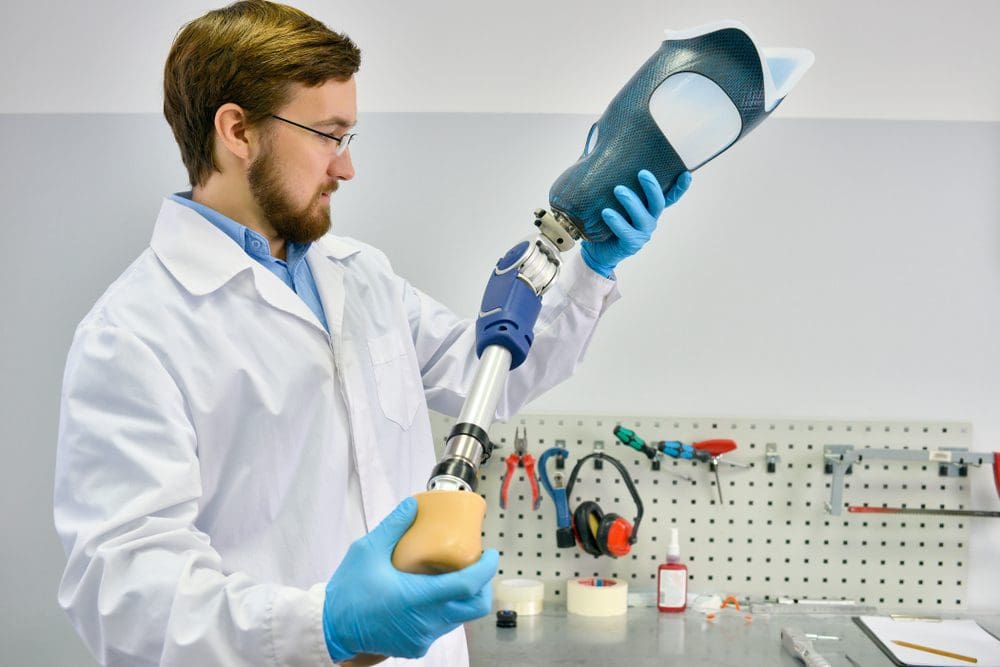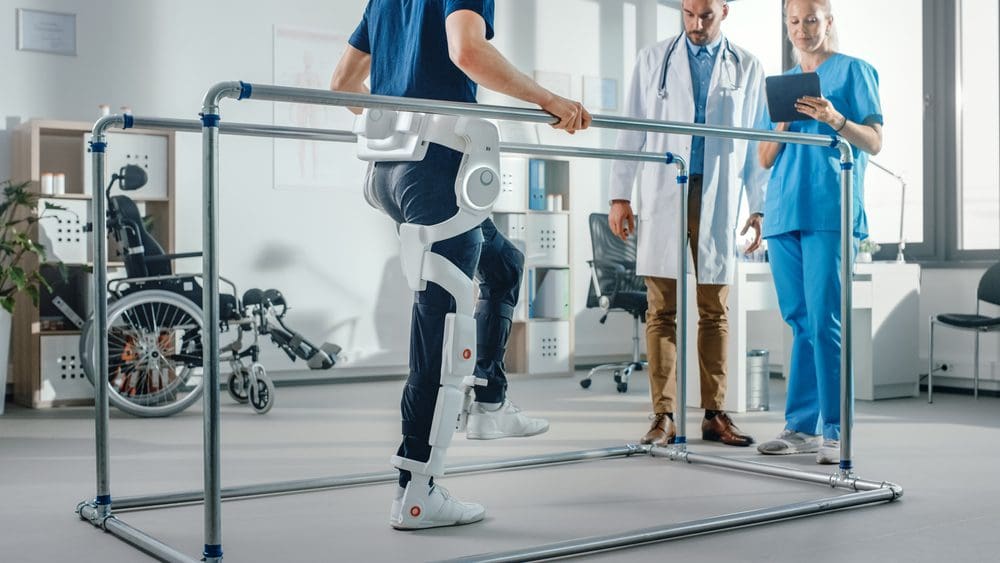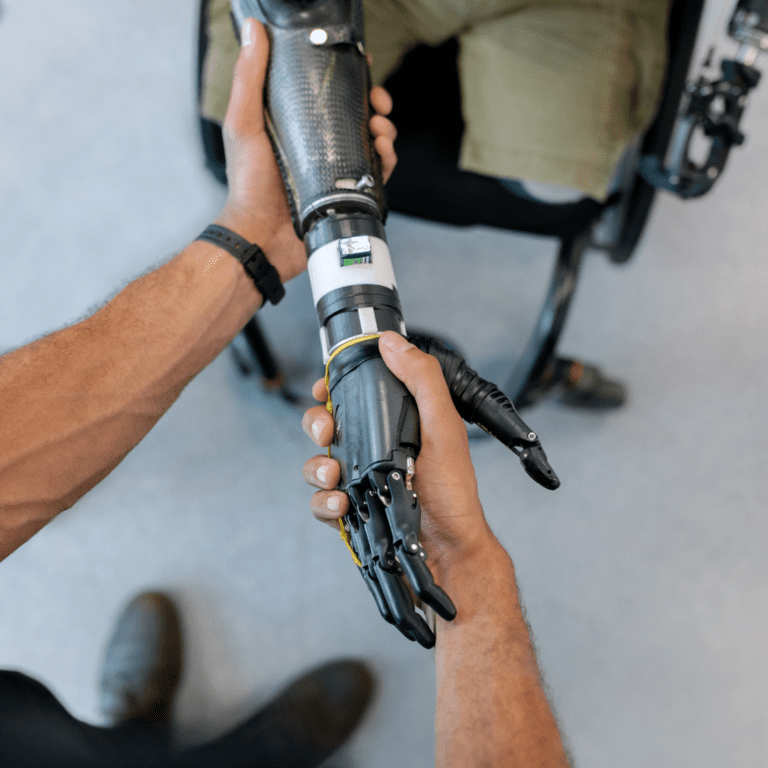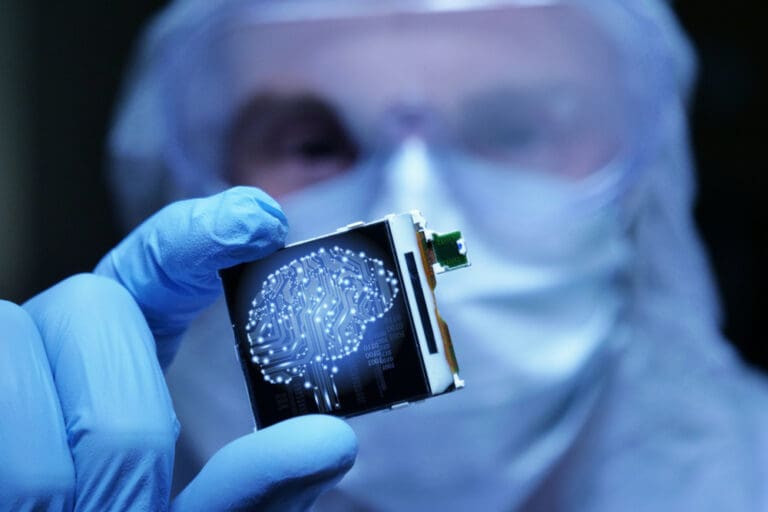The use of prosthetic limbs have come a long way over recent generations. Now they could be about to take another giant stride forward.
Not only could they be on the cusp of offering unparalleled control methods but even deliver a realistic sensation to the user of what they are feeling through texture, weight and even heat.
In short, dramatically improving the quality of life for those in need of them.
It is estimated around nearly 60 million people worldwide have experience limb loss through trauma. Many others are born without them.
All of which means the latest robotic prosthetics being developed – coupled with cutting edge AI – could be about to transform many lives.
While those in need of a prosthesis have long had options, they have tended to be unresponsive and basic; limiting movement and offering minimal comfort.
But a new breed of robotic prosthetics are emerging designed to challenge that.
Perhaps more excitingly, when combined with AI, they promise the user a highly intuitive replacement limb.
Growing global market

According to a report published in February 2023 by Global Market Insights, the global market for robotic prosthetics was in excess of USD1 billion by the end of 2022.
It predicts that will rise to closer to USD3 billion by 2032 – with a CAGR of 10.5%.
Part of that growth, it believes, will be as the result of a condition on the rise in the developed world.
Explains the report:
“The growing need for limb amputation can be attributed to the rising prevalence of diabetes in developed and developing countries; driven by unhealthy dietary habits and sedentary lifestyles.
“As per the National Diabetes Foot Care Audit (NDFA), nearly 60,000 diabetic patients in England suffer from diabetic foot ulceration. Diabetes-related health complications, such as poor blood circulation and nerve damage, are one of the leading causes of ulcers and peripheral artery disease, necessitating advanced limb amputation procedures and implants, subsequently helping the industry’s growth.”
So there is likely to be a growing market. Not to mention a demand for more sophisticated bionic prosthetics devices by those who already use them.
There are plenty of start-ups already in the sector – developing and improving on tried and tested technology. The likes of ReWalk Robotics, for example. The Israeli firm provides complex systems for those with lower limbs missing or recovering from strokes. It has already attracted more than USD210 million in funding.
Ekso Bionics in the US has developed a range of exoskeletons to assist those with paralysis. It has attracted almost USD190 million in funding. While French firm Wandercraft has developed a hands-free exoskeleton to bring movement back to those unable to do so.
It has pulled in more than USD75 million in investment so far.
Revolutionising the industry with AI

While recent technological developments in the sector have made the limbs available today far more sophisticated – fingers can move independently, users can have control over multiple joints – the end-user experience can still be challenging and unsatisfying.
Most of the most modern devices in use today harness what are known as myoelectric sensors. They are implanted in or near a muscular part of the body and read the electric outputs of them.
It allows the device to measure the degree of activation of the muscle.
But it has its limitations. The pulse of the muscles rarely equates to the brain’s natural communication to the limbs meaning generating the movement for the user is rarely intuitive. In can also take months to master.
Last year, researchers at the University of Minnesota developed a more accurate, less invasive technology that allows amputees to move a robotic arm using their brain signals instead of their muscles; a move designed to be far closer to replicating that natural brain to nerve signal.
With the help of industry collaborators, they have created a small, implantable device that attaches to the peripheral nerve in a person’s arm. When combined with an AI computer and a robotic arm, the device can read and interpret brain signals, allowing upper limb amputees to control the arm using only their thoughts.
“It’s a lot more intuitive than any commercial system out there,” said Jules Anh Tuan Nguyen, a postdoctoral researcher and University of Minnesota biomedical engineering PhD graduate.
“With other commercial prosthetic systems, when amputees want to move a finger, they don’t actually think about moving a finger. They’re trying to activate the muscles in their arm, since that’s what the system reads.
“Because of that, these systems require a lot of learning and practice. For our technology, because we interpret the nerve signal directly, it knows the patient’s intention. If they want to move a finger, all they have to do is think about moving that finger.”
It has now launched a start-up called Fasikl to commercialise the technology behind it.
Increasing investment in new start-ups
New York-based Synchron is a bioelectronics medicine company which tackles a range of previously-untreatable nervous system conditions – among them using brain signals to control prosthetics.
Describing itself as a brain-computer interface company, at the end of 2022, it saw an over-subscribed Series C USD75 million funding round. It brought the total raised since its inception to USD145 million.
Among those latest investors was Amazon founder Jeff Bezos. Bill Gates has also sunk dollars into its R&D.
The firm specialises in looking to give paralysed patients the opportunity to regain movement by its technology being implanted through blood vessels to operate various devices. It remains in the earliest stages but the results so far have been encouraging.
At North Carolina State University, researchers have developed new software that can be integrated with existing hardware to enable people using robotic prosthetics or exoskeletons to walk in a safer, more natural manner on different types of terrain.
The new framework incorporates computer vision into prosthetic leg control and includes AI algorithms that allow the software to better account for uncertainty.
“Lower-limb robotic prosthetics need to execute different behaviours based on the terrain users are walking on,” says Edgar Lobaton, co-author of a paper on the work and an associate professor of electrical and computer engineering at the university. “The framework we’ve created allows the AI in robotic prostheses to predict the type of terrain users will be stepping on, quantify the uncertainties associated with that prediction, and then incorporate that uncertainty into its decision-making.”
Yet despite the progress there remains a problem which is unlikely to surmounted any time soon – economics.
The World Health Organisation estimates that, today, only one in ten people in need has access to assistive products, including prostheses and orthoses, because of their high cost and because of lack of awareness, availability, trained personnel, policy and financing.
And the new era of products – as and when they emerge on the market – are likely to be far out of the reach of many, given their high costs.
Which presents a significant challenge.
However, as with all new technology, while entry costs will undoubtedly be high, as take up picks up so prices will drop. Without that, it will be a breakthrough with limited commercial clout.
Conclusion
The potential to transform lives by marrying cutting-edge robotics with advances in AI is a compelling one. The biggest challenge remains making these state-of-the-art devices affordable to all potential recipients. Currently the technology is subject to considerable R&D investment and that can eat up investor dollars. But the rewards, if it can be proven to deliver to scale and at a price-point which doesn’t cut the majority out of the equation, could be significant.
Companies to Watch
Synchron, Fasikl, Wandercraft, Ekso Bionics, ReWalk Robotics








